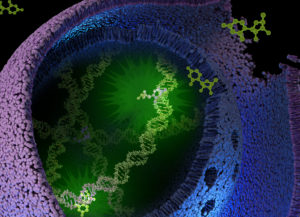A recent paper in PLOS One demonstrated real-time cytotoxicity profiling of approximately 10,000 chemical compounds in the Tox21 compound library, using two Promega assays, RealTime-Glo™ MT Cell Viability Assay and CellTox™ Green Cytotoxicity Assay. This is exciting to me, a science writer working at Promega; exciting because it’s tricky figuring out how to write about the utility of our products without sounding like an evangelist.
I don’t know about you, but I tend to shut out evangelists and their messages.
Instead of me telling you about real-time viability and cytotoxicity assays from Promega, here is an example of their use in Tox21 chemical compound library research.
What is the Tox21 compound library?
As described in the article by Hsieh, J-H. et al. (2017) in PLOS One:
“The Toxicology in the 21st Century (Tox21) program is a federal collaboration among the National Institutes of Health, including the National Toxicology Program (NTP) at the National Institute of Environmental Health Sciences and the National Center for Advancing Translational Sciences, the Environmental Protection Agency, and the Food and Drug Administration. Tox21 researchers utilize a screening method called high throughput screening (HTS) that uses automated methods to quickly and efficiently test chemicals for activity across a battery of assays that target cellular processes. These assays are useful for rapidly evaluating large numbers of chemicals to provide insight on potential human health effects.”
Tox21 goals
The Tox21 screening program goals “include the prioritization of chemicals with little or no toxicological data”, to gain a more in-depth valuation of mechanism-based activity data and for development of models for better predicting in vivo toxicity of new chemical entities. These tests use mechanism- and cell-based quantitative high-throughput (qHTS) assays focusing on nuclear receptor and stress response pathways (Hsieh, et al.).
Where do the compounds come from?
The compounds in the library represent a wide variety of chemicals that you and I might routinely come into contact with, including pesticides, industrial chemicals, natural food products and drugs. The drugs tested include those that did not pass clinical trials, are no longer available for use and drugs currently in use.
What was done in this report?
In this May 2017 article, “Real-time cell toxicity profiling of Tox21 10K compounds reveals cytotoxicity dependent toxicity pathway linkage”, 9,667 compounds were screened for toxicity. Each compound was prepared as a stock solution in DMSO, and serially diluted to 15 concentrations, usually ranging from 1nM to 77µM. The compounds were plated on 1536-well plates; 88 duplicate compounds were purposely included on each plate to enable evaluation of variability across both plates and runs.
The authors tested chemical-induced cytotoxicity at six different time points (0, 8, 16, 32 and 40 hours) using two cell lines, HEK293 and HepG2, and two assays to determine real-time cytotoxicity: the RealTime-Glo™ MT Cell Viability Assay and CellTox™ Green Cytotoxicity Assay.
About the real-time assays and what they teach us
The uber-useful thing about real-time assays is that they work without killing the cells. This means you can assay the same cells/same plate wells multiple times. For example, this study measured six different time points between 0 and 40 hours. A real-time assay provides the best possible means to evaluate the state of your cells, now, in 5, or 15 or 60 minutes, and even hours after treatment.
The RealTime-Glo™ MT Cell Viability Assay works by measuring the reducing potential of cells, that is the cells’ metabolic activity or viability. A dead cell has no metabolic footprint. RealTime-Glo™ MT Assay bioluminescent readout is based on a luciferase substrate that is only produced in live cells.
The CellTox™ Green Cytotoxicity Assay detects the loss of cell membrane integrity or cell death, via a pro-fluorescent DNA-binding dye. This dye cannot penetrate an intact, viable cell membrane, so the dye is excluded by live cells. DNA staining, which results in fluorescence, only occurs in dead cells whose membrane is no longer intact.
A key finding of this work is that the assay that you choose matters. In this study the two assays, because of they measure two different parameters of cell health (metabolic potential and membrane integrity), revealed differences that might have remained hidden had the researchers only used one assay. The RealTime-Glo™ Assay revealed cytotoxic differences between the cell lines because it looks at metabolic activity. The assay also revealed some kinetic variations and compound sensitivity variations between the cells. For instance, HEK cells seemed to respond more quickly to the TOX21 compounds than the Hep2G cells. Had the researchers only used a membrane integrity assay, these differences would have been missed.
You can find detailed data and other resources about the RealTime-Glo™ Assay and CellTox™ Green Assay on these, their respective product pages.
Performance of RealTime-Glo™ MT Cell Viability Assay and CellTox™ Green Cytotoxicity Assay
You can review the complete results for the 9,667 compounds tested in this study by reading the paper and viewing the related website (Hsieh et al.). See the link at the end of this blog.
Here, however, are some performance details for these two assays. The authors note that “the two assay technologies performed well in both cell lines” and list these qHTS assay performance statistics:
- signal:background (S/B) ratio ranged from three- to sixfold
- coefficient of variance (CV) of 6–8%
- Z′ factor >0.7
- overall standard deviation of half maximal effect, EC50, or inhibitory concentration, IC50 of the positive control compound, tetra-N-octylammonium bromide titration that was added to each plate was <3-fold
Hsieh et al. write in greater detail about the importance of cytotoxicity testing on such compounds and why these two assays were chosen. You can see the data and read more, here:
Hsieh, J-H. et al. (2017) Real-time cell toxicity profiling of Tox21 10K compounds reveals cytotoxicity dependent toxicity pathway linkage. PLOS One 12(5), e0177902 .PMID 28531190

